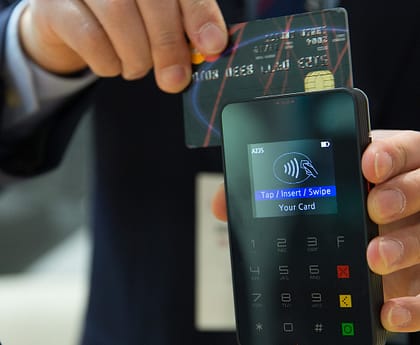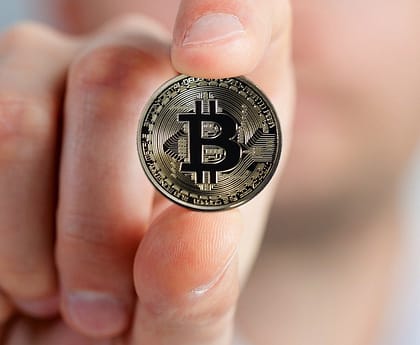What is Bitcoin?
BTC, short for Bitcoin, is a decentralized virtual currency that was invented by Satoshi Nakamoto. The anonymous inventor or group published a white paper in 2008 as a proof of concept, then released it as open-source prototype software in 2009. Bitcoin uses peer-to-peer technology to operate without a central authority or banking institution; managing transactions and issuing new BTC, also known as mining, is carried out collectively by the network. Bitcoin has many unique characteristics compared to traditional credit cards such as international payments, low transaction fees, irreversible transactions for merchants, and security through encryption.
HOW IS NEW BITCOIN CREATED?
Bitcoins are only created as a reward for proof of work involving cryptographic hashes called mining. Users offer their computing power to verify and record payments in to a public ledger, known as the blockchain. Bitcoin that is already mined is in circulation and can be exchanged for goods and services. There will only ever be 21 million bitcoins in existence, with the final fractions of bitcoin being redeemed by miners in the year 2140. If this great bitcoin experiment succeeds and people still use it after that point, BTC miners will be supported exclusively by numerous small transaction fees – which are required to let your transactions be included swiftly into the blockchain. However, these coins can be divisible into smaller units, unlike regular currencies bitcoins are divisible by up to 10^8, which means that over time people will have the ability to use tiny little fractions of bitcoin to buy things. The smallest divisible unit of a bitcoin is aptly named a ‘Satoshi’.
HOW DOES BITCOIN PRICE CALCULATED?
The price of bitcoin is determined by its supply and demand. When demand for bitcoin increases, the price increases, and when demand falls, the price falls. There is only a limited number of BTC in circulation and new bitcoins are created at a predictably diminished rate. Demand must follow this level of inflation to keep the price stable.
WHY DO PEOPLE TRUST BITCOIN?
Unlike centralized fiat payment systems, Bitcoin is fully open-source and decentralized. Transactions can be verified independently at any time. Bitcoin payments can be made instantly and directly without an intermediary. The whole system is protected by a combination of elliptic curve cryptography and hashing on the sha256 curve. Together these mechanisms sufficiently provide large enough random key-space that cannot be attacked by hackers or gamed through mathematics.
WHO CONTROLS THE BITCOIN NETWORK?
No organization or individual wields total control of the entire network. The Bitcoin network has no dependence on a central authority nor a single administrator. Managing transactions and issuing new bitcoins are carried out collectively on the above mentioned blockchain. The Bitcoin protocol itself cannot be modified without the cooperation of nearly all its users to aggregately run updated software.
WHAT ARE THE CHARACTERISTICS THAT MAKE BITCOIN DIFFERENT TO CONVENTIONAL MONEY?
Bitcoin has several features that it different than government backed currencies:
The very Decentralized nature of Bitcoin sets it above from conventional money that is issued by a central bank or federal agency.
It is very easy to setup Bitcoin Software and Take Payments- Unlike a conventional bank account, you can set up a bitcoin address in seconds without any fees or documentation.
The anonymous nature of Bitcoin sets it apart from conventional money. A bank account has links to your real name and other personally identifying information.
Transparency on the blockchain makes it different to conventional money. All bitcoin transactions and newly issued bitcoins are recorded in public view and can be seen in real-time.
Ease of transferring money- you can send and receive money anywhere in the world within minutes, as soon you broadcast the transaction, it gets confirmed and spread to the other peers within the network.
You can choose your own fees while spending your bitcoin. Paying high transaction fees can encourage very fast conformation on the bitcoin network. However, Fees are unrelated to the amount transferred, so it’s possible to send 10,000 BTC with no fee, and just wait a bit longer for them to be confirmed (Up to three days.)
Bitcoin transactions are secure, irreversible, and do not contain customers’ sensitive or personal information. This offers strong protection against identity theft compared to checks or credit cards.
Find Out Who Is Satoshi Nakamoto?
Satoshi Nakamoto is the pseudonym used by a people or group of people who invented Bitcoin. Satoshi developed the original protocol and the blockchain technology that underlies bitcoin, Satoshi’s real identity is unknown.
Satoshi Nakamoto is actually a pseudonym for either one person or a group of people, the identity is currently unknown. This entity was the creator of Bitcoin and the bitcoin whitepaper. On his P2P foundation account, he professed to be a 37-year-old Japanese native, but due to his perfect use of English and the Bitcoin software not being labelled or translated at the time into Japanese, this is called into question.
Occasional use of British English in the code and comments lead to speculation that Satoshi may be of common wealth origin. People have deduced that due to the fact Satoshi’s posting times were silent between 5 – 11AM British time, if Satoshi had a normal sleeping pattern then he would reside in the GMT -5 to GMT -6 region.
PEOPLE SUSPECTED OF BEING SATOSHI NAKAMOTO
There have been many high profile cases of people claiming to be Satoshi Nakamoto in recent years or people the media suspected of being Satoshi Nakamoto. All of these have been debunked. One way of proving a person is Satoshi is to sign a message with the keys from the first ever blocks of Bitcoins which Satoshi mined, or the genesis block addresses. None of these could do it (or denied that they could) and some denied even being Satoshi.
NICK SZABO
Nick Szabo designed ‘bit gold’ which was a precursor to Bitcoin. He was interested in digital currency and also liked to use pseudonyms. He was suspected by many people and media outlets of being Satoshi Nakamoto, a claim he denies. The evidence he was Satoshi was only circumstantial.
Dorian Nakamoto
In march 2014 an article in the Newsweek magazine, a journalist named Leah McGrath Goodman attempted to identify a Japanese American man from California as Satoshi, as his birth name was Satoshi Nakamoto. The person in question was also a systems engineer and financial information services.
The publication of this article lead to a lot of media interest, with reporters waiting near the home of Dorian Nakamoto and following him in their cars to try and get an interview. He denied making Bitcoin and even denied knowing what it was.
Satoshi posted from his P2P foundation account stating he was not Dorian Nakamoto.
HAL FINNEY
Hal Finney was a cryptographic engineer in the pre-bitcoin era who was also the first person to use the Bitcoin software after Satoshi Nakamoto, and to file bug reports. He also helped make improvements to the Bitcoin client. He also received the first Bitcoin transaction.
He also lived not too far from the home of Dorian Nakamoto. His writing style came close to that of Satoshi Nakamoto. After people saw that he had emailed Satoshi many times, and the fact that Satoshi had sent him the first Bitcoin transaction, and the fact that Hal denied being Satoshi, he was concluded not to be Satoshi.
CRAIG STEVEN WRIGHT
Craig Wright was an Australian citizen who attempted to say he was Satoshi Nakamoto. He claimed to be Satoshi Nakamoto and when police raided his house on a separate issue, the media suspected that he was Satoshi further. He posted in his blogs claiming to be Satoshi Nakamoto.
BBC Journalists attempted to say they saw Wright signing a message using the private keys associated with the first Bitcoin transactions. When one of the bitcoin developers looked at Wrights blog posts to check the poof, it did not contain any.
He made a post stating he would publish further proof, but then deleted his post and stated he could not stand being in the spotlight.
Having never really signed a message from the private keys of the earliest Bitcoin transactions, he was deemed not to be Satoshi Nakamoto, but potentially a skilled hoaxer.
SUMMARY
These are the 4 main people who were suspected of being Satoshi Nakamoto and was since debunked. There have been many others, but these are the main ones that bought widespread media attention. The founder of Bitcoin still remains Anonymous to this day.
WHY DID SATOSHI NAKAMOTO HIDE HIS IDENTITY?
There are many speculated reasons as to why Satoshi Nakamoto hid his identity. The main reason is due to the high profile nature of Bitcoin; he did not want the attention. Satoshi handed the Bitcoin project over not long after Gavin Andersen who is a Bitcoin developer gave a talk on bitcoin to the CIA.
There is speculation that this concerned Satoshi, but there is little more than speculation at this point. A well-known spiritual conspiracy theorist, who does back up a lot of his stories with hard science, stated that he had heard that Bitcoin was created by an international alliance to have a currency that could be used in the event that the cabal attempted to crash the current banking system which they control.
David Wilcock has little knowledge about Bitcoin itself, however, and he did not realize that Satoshi Nakamoto embedded a message in the Genesis block, which is block 0. It mentioned the bank bailouts of 2009, implying that corruption in the banking system is one of the reasons why he created a currency like Bitcoin.
Due to the potential risk to life developing something like this and the risk of being a public celebrity, it is likely he chose to hide his identity for his own protection, especially when Bitcoin was associated in the media as being the currency of criminals when it actually has many legitimate uses.
WILL WE EVER FIND OUT WHO SATOSHI NAKAMOTO IS?
There is speculation, but currently only speculation. Members of the Bitcoin community have refused to believe anyone claiming to be Satoshi Nakamoto, unless they sign a message with the private keys from Satoshi’s known coins or the Genesis block. Due to the disappearance of Satoshi Nakamoto, some have said that after a few years his massive coin stash (1 million plus coins) should be disabled as they are supposedly a ‘security’ risk. This was met with backlash by the community and the Bitcoin developers did not implement this. Even if they did, it would require network consensus to achieve.
There have been some who were happy that Satoshi left the project, many see him as a potential idol, judging by forum posts on bitcointalk. His sudden disappearance leads many people to continuously wonder who he is and people are still trying to find him to this day. If he hid his identity properly, this is a very difficult, if not impossible task unless he comes forward.
Blockchain analysis shows that almost none of his coins have even been spent and have remained untouched for several years.
SUMMARY
This article has discussed who Satoshi Nakamoto was, and has gone over a few people suspected of being Satoshi Nakamoto. None of their identities were found to be that of Satoshi Nakamoto. It is likely that Satoshi was either a person or a group of people, and could potentially fear the CIA.
It is a potential that he helped develop Bitcoin as an alternative to the traditional financial system, in the hands of the people, this was evidenced by the genesis block. People still speculate to this day, but still, there is no hard concrete proof of who is Satoshi Nakamoto. Satoshi cannot cause harm to the Bitcoin network, the way he designed it meant it was out of his hands once other nodes started coming online.
CONCLUSION
He may come forward one day, but no one knows when or if he will come forward, and none of his coins have been spent, even though the value of his holdings tops $600 million, so profit was not his motive. He could have cashed these coins out at any time but chose not to. It is likely he will remain just the Satoshi Nakamoto pseudonym for the time being, but this could change in the future. The creation of Satoshi Nakamoto still runs and is maintained by the current developers.




